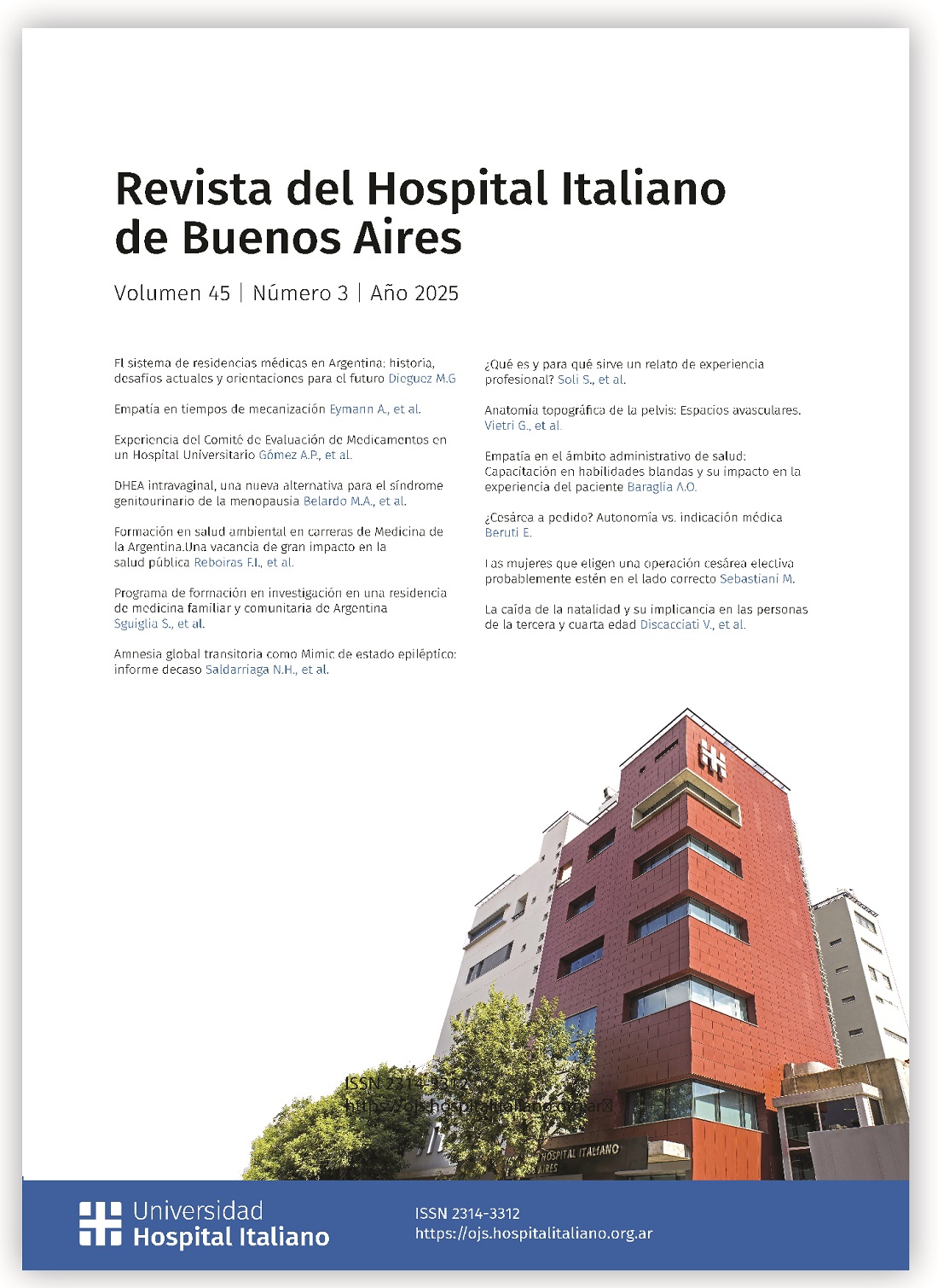Español Intravaginal DHEA: A New Alternative for Genitourinary Syndrome of Menopause
Main Article Content
Abstract
Introduction: Menopause, a natural stage in a woman's life, causes hormonal changes that can affect health, particularly the genitourinary tract, leading to the genitourinary syndrome of menopause (GSM). This syndrome usually presents genital and urinary symptoms and sexual dysfunction. Despite its high prevalence, many women do not seek appropriate treatment due to a lack of information or the stigma associated with these symptoms. However, therapeutic options such as intravaginal dehydroepiandrosterone (DHEA) or prasterone (prasterone 6.5 mg) have proven effective in treating GSM symptoms.
State of the Art: DHEA is locally converted into androgens and estrogens in the vaginal mucosa through intracrinology, improving vaginal health and sexual function. In clinical studies, intravaginal DHEA has been shown to reduce dyspareunia, improve vaginal pH, lubrication, and mucosal integrity. The benefits of intravaginal DHEA were comparable to or even greater than those of other treatments, such as vaginal estrogens.
The administration of 0.5% DHEA intravaginally in postmenopausal women significantly improved GSM symptoms, reducing dyspareunia and enhancing quality of life. DHEA has also been shown to improve sexual function in women with low levels dehydroepiandrosterone sulfate (DHEA-S) and testosterone. Regarding safety, it was observed that it does not have significant effects on the endometrium nor does it alter serum steroid levels.
Conclusion: Daily vaginal DHEA is as effective as local estrogens. It has beneficial effects on the anatomy and physiology of vulvovaginal atrophy and all associated symptoms and signs without systemic exposure, according to the intracrinology mechanism.
Downloads
Article Details
Section

This work is licensed under a Creative Commons Attribution-NonCommercial-ShareAlike 4.0 International License.
How to Cite
References
Kim HK, Kang SY, Chung YJ, et al. The recent review of the genitourinary syndrome of menopause. J Menopausal Med. 2015;21(2):65-71. https://doi.org/10.6118/jmm.2015.21.2.65. DOI: https://doi.org/10.6118/jmm.2015.21.2.65
Nik Hazlina NH, Norhayati MN, Shaiful Bahari I, et al. Prevalence of psychosomatic and genitourinary syndrome among menopausal women: a systematic review and meta-analysis. Front Med (Lausanne). 2022;9:848202. https://doi.org/10.3389/fmed.2022.848202. DOI: https://doi.org/10.3389/fmed.2022.848202
Mili N, Paschou SA, Armeni A, et al. Genitourinary syndrome of menopause: a systematic review on prevalence and treatment. Menopause. 2021;28(6):706-716. https://doi.org/10.1097/GME.0000000000001752. 2. DOI: https://doi.org/10.1097/GME.0000000000001752
Traish AM, Vignozzi L, Simon JA, et al. Role of androgens in female genitourinary tissue structure and function: implications in the genitourinary syndrome of menopause. Sex Med Rev. 2018;6(4):558-571. https://doi.org/10.1016/j.sxmr.2018.03.005. 4. DOI: https://doi.org/10.1016/j.sxmr.2018.03.005
Tang J, Chen LR, Chen KH. The utilization of dehydroepiandrosterone as a sexual hormone precursor in premenopausal and postmenopausal women: an overview. Pharmaceuticals (Basel). 2021;15(1):46. https://doi.org/10.3390/ph15010046. DOI: https://doi.org/10.3390/ph15010046
Labrie F, Archer D, Bouchard C, et al. High internal consistency and efficacy of intravaginal DHEA for vaginal atrophy. Gynecol Endocrinol. 2010;26(7):524-532. https://doi.org/10.3109/09513590903511547. DOI: https://doi.org/10.3109/09513590903511547
Labrie F, Archer DF, Bouchard C, et al. Intravaginal dehydroepiandrosterone (prasterone), a highly efficient treatment of dyspareunia. Climacteric. 2011;14(2):282-288. https://doi.org/10.3109/13697137.2010.535226. DOI: https://doi.org/10.3109/13697137.2010.535226
Labrie F, Archer DF, Koltun W, et al. Efficacy of intravaginal dehydroepiandrosterone (DHEA) on moderate to severe dyspareunia and vaginal dryness, symptoms of vulvovaginal atrophy, and of the genitourinary syndrome of menopause. Menopause. 2018;25(11):1339-1353. https://doi.org/10.1097/GME.0000000000001238. DOI: https://doi.org/10.1097/GME.0000000000001238
Labrie F, Archer DF, Bouchard C, et al. Prasterone has parallel beneficial effects on the main symptoms of vulvovaginal atrophy: 52-week open-label study. Maturitas. 2015;81(1):46-56. https://doi.org/10.1016/j.maturitas.2015.02.005. DOI: https://doi.org/10.1016/j.maturitas.2015.02.005
Sauer U, Talaulikar V, Davies MC. Efficacy of intravaginal dehydroepiandrosterone (DHEA) for symptomatic women in the peri- or postmenopausal phase. Maturitas. 2018;116:79-82. https://doi.org/10.1016/j.maturitas.2018.07.016. DOI: https://doi.org/10.1016/j.maturitas.2018.07.016
Duarte PR, Maroto Martín MT, Mar Martín Moya MD, et al. Quality of life analysis measured with the Cervantes 16 scale in treated menopausal women with genitourinary syndrome. J Comp Eff Res. 2022;11(18):1365-1374. https://doi.org/10.2217/cer-2022-0086. DOI: https://doi.org/10.2217/cer-2022-0086
Bouchard C, Labrie F, Archer DF, et al. Decreased efficacy of twice-weekly intravaginal dehydroepiandrosterone on vulvovaginal atrophy. Climacteric. 2015;18(4):590-607. https://doi.org/10.3109/13697137.2014.992012. DOI: https://doi.org/10.3109/13697137.2014.992012
Ke Y, Gonthier R, Simard JN, et al. Serum steroids remain within the same normal postmenopausal values during 12-month intravaginal 0.50% DHEA. Horm Mol Biol Clin Investig. 2015;24(3):117-129. https://doi.org/10.1515/hmbci-2015-0035. DOI: https://doi.org/10.1515/hmbci-2015-0035
Portman DJ, Labrie F, Archer DF, et al. Lack of effect of intravaginal dehydroepiandrosterone (DHEA, prasterone) on the endometrium in postmenopausal women. Menopause. 2015;22(12):1289-1295. https://doi.org/10.1097/GME.0000000000000470. DOI: https://doi.org/10.1097/GME.0000000000000470
Mension E, Alonso I, Cebrecos I, et al. Safety of prasterone in breast cancer survivors treated with aromatase inhibitors: the VIBRA pilot study. Climacteric. 2022;25(5):476-482. https://doi.org/10.1080/13697137.2022.2050208. DOI: https://doi.org/10.1080/13697137.2022.2050208
Barton DL, Sloan JA, Shuster LT, et al. Evaluating the efficacy of vaginal dehydroepiandosterone for vaginal symptoms in postmenopausal cancer survivors: NCCTG N10C1 (Alliance). Support Care Cancer. 2018;26(2):643-650. https://doi.org/10.1007/s00520-017-3878-2. DOI: https://doi.org/10.1007/s00520-017-3878-2
Barton DL, Shuster LT, Dockter T, et al. Systemic and local effects of vaginal dehydroepiandrosterone (DHEA): NCCTG N10C1 (Alliance). Support Care Cancer. 2018;26(4):1335-1343. https://doi.org/10.1007/s00520-017-3960-9. DOI: https://doi.org/10.1007/s00520-017-3960-9
Bouchard C, Labrie F, Derogatis L,et al. Effect of intravaginal dehydroepiandrosterone (DHEA) on the female sexual function in postmenopausal women: ERC-230 open-label study. Horm Mol Biol Clin Investig. 2016;25(3):181-190. https://doi,org/10.1515/hmbci-2015-0044. DOI: https://doi.org/10.1515/hmbci-2015-0044
Pelletier G, Ouellet J, Martel C, et al. Androgenic action of dehydroepiandrosterone (DHEA) on nerve density in the ovariectomized rat vagina. J Sex Med. 2013;10(8):1908-1914. https://doi.org/10.1111/jsm.12219. DOI: https://doi.org/10.1111/jsm.12219
Matarazzo MG, Sarpietro G, Fiorito D, et al. Intravaginal 6.5 mg prasterone administration in postmenopausal women with overactive bladder syndrome: a pilot study. Eur J Obstet Gynecol Reprod Biol. 2021;263:67-71. https://doi.org/10.1016/j.ejogrb.2021.06.009. DOI: https://doi.org/10.1016/j.ejogrb.2021.06.009
Misasi G, Russo E, Montt Guevara MM, et al. Effects of vaginal DHEA on stress urinary incontinence in postmenopausal women with vulvovaginal atrophy. Maturitas. 2025;196:108232. https://doi.org/10.1016/j.maturitas.2025.108232. DOI: https://doi.org/10.1016/j.maturitas.2025.108232

